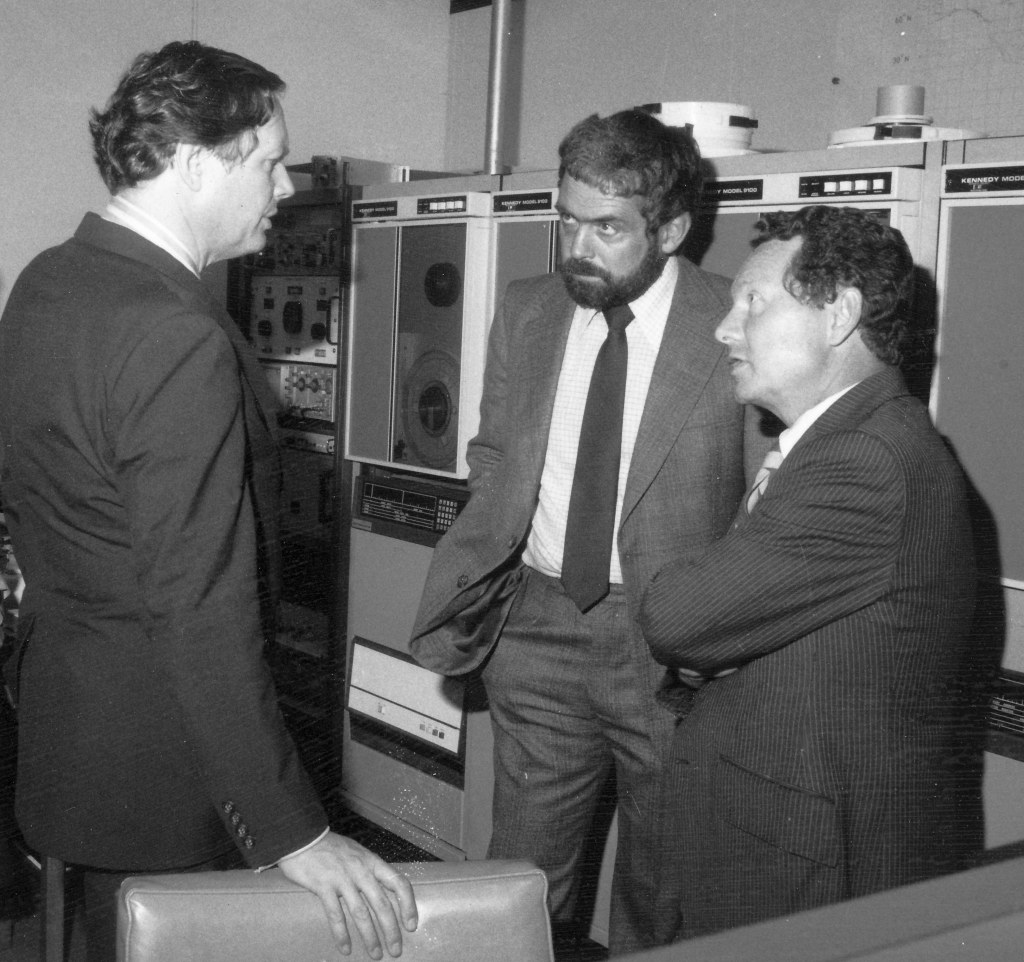Environment Minister Visits Downsview - 22 September 1980
left to right in photosSee also MP Roger Simmons in 1981 follow-up visit
Photo Published in Zephyr Environment Minister John Roberts (left) chats with Graeme Morrissey (centre), Chief Aerospace Meteorology Division, and ADM Jim Bruce (right) during the Minister's visit to AES satellite facilities. See Story below photos. |
Original Uncropped Photo  ? (assistant to Minister Roberts), John Roberts, Graeme Morrissey, Jim Bruce scroll down for text of original Zephyr article |
Jim Bruce Welcomes Minister in Auditorium |
Environment Minister John Roberts |
Photo 4 Jim Bruce, ? (Min. Assistant), (backs) John Roberts, Graeme Morrissey |
Photo 5 (back) Jim Bruce, Graeme Morrissey, John Roberts |
Photo 6 ?, John Roberts, Jim Bruce |
Follow-up Visit by
Parliamentary Secretary,
October 1981 Graeme Morrissey, left explains some of the operations of the AES satellite data lab to Roger Simmons, MP, parliamentary secretary to Environment Minister John Roberts (photo by John Lewis). See more below |
Outlier Photo from 1980 film Karl Vanek |
Published in the September / October 1980 edition of Zephyr Photo with Roger Simmons published in November / December 1981 edition of Zephyr * * * Details Below |
|
Environment Minister Visits AES
Environment Minister John Roberts visited AES Downsview on September 22, 1980. Speaking to a large audience gathered in the auditorium, he told members of the Service: "I am impressed by the quality of your contributions to programs affecting the safety of Canadians, the national economy, the quality of the environment and the advancement of science." Mr. Roberts urged his hearers to pay special attention to the global and long-term challenges facing the world as well as Canada. Exploding world population, poverty, disease, shortages of food, energy and water, disappearance of forests, agricultural soil deterioration, plants and animal species extinction, pollution, climate change, and the spread of hazardous wastes were some of the enormous problems closing in upon all nations. Present trends could only be reversed if unprecedented levels of cooperation, goodwill and commitment were forthcoming, he said. On a more optimistic note, Mr. Roberts added: "I believe there is still reason for hope; that opportunities exist for vigorous and determined new initiatives; that public attitudes and national policies can be altered with regard to energy resources conservation, population stabilization and environmental protection." The DOE response to the acid rain challenge both pleased and impressed Mr. Roberts. Core programs in atmospheric physics and chemistry made such a response possible and should continue to address other national and global concerns, such as the transport of atmospheric chemicals, climate change, and the carbon dioxide problem. Mr. Roberts then spoke of the high technology component of his second portfolio, the Ministry of State for Science and Technology, and mentioned in particular the space program and the vector computer (the latest generation of computers). Following his address, the Minister visited AES satellite facilities and was briefed on the latest meteorological applications of Canada's space program. The last minister to visit AES was Mr. Len Marchand, on June 5, 1978. The occasion was the opening of an extension to the Satellite Data Laboratory and the installation of a dish antenna receiving imagery from the GOES-EAST satellite. A deep involvement in acid' rain and a keen perception of the role of AES in the Canadian government's efforts to combat it was shown by Roger Simmons, Parliamentary Secretary to Environment Minister, John Roberts, and MP for Burin - St George's, Nfld., when he visited the Downsview location October 1st 1981. After being met at the airport by Dr. Warren Godson, Director General of the Research Directorate, Mr. Simmons made it clear he was particularly interested in how fallout is related to its source. He was told how a computer model has been developed that makes this possible. The method of analyzing air samples and the tracks followed by various air pollutants were explained to the visitor by Peter Summers of the LRTAP Scientific Co-ordination office. Dr. Summers told him that while there has been some question about past measurements, there has been no argument about current figures, only about their interpretation. "This is something I'm glad to hear," said Mr. Simmons," because the U.S. has been taking pot-shots at our credibility with regard to the Canadian claim that most of our acid rain comes from there." In addition, Mr. Simmons met Dr. Al Christie for a brief tour of the AES Air Quality research facilities. Finally he was given a tour of the satellite data laboratory by Graeme Morrissey, head of the Aerospace Meteorology Division. |